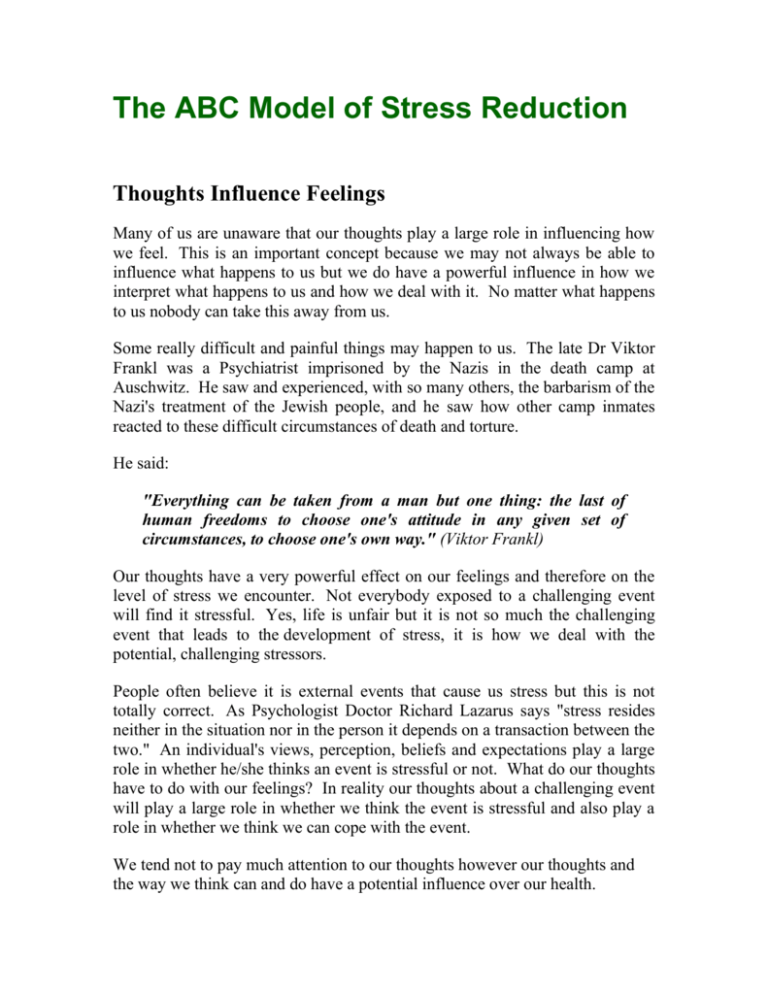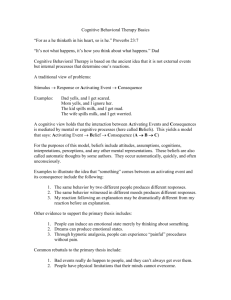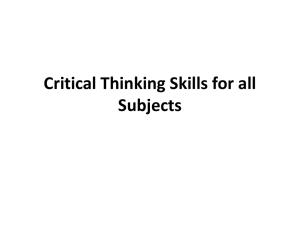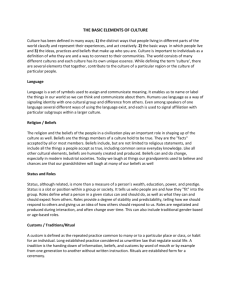The ABC Model of Stress
advertisement

The ABC Model of Stress Reduction Thoughts Influence Feelings Many of us are unaware that our thoughts play a large role in influencing how we feel. This is an important concept because we may not always be able to influence what happens to us but we do have a powerful influence in how we interpret what happens to us and how we deal with it. No matter what happens to us nobody can take this away from us. Some really difficult and painful things may happen to us. The late Dr Viktor Frankl was a Psychiatrist imprisoned by the Nazis in the death camp at Auschwitz. He saw and experienced, with so many others, the barbarism of the Nazi's treatment of the Jewish people, and he saw how other camp inmates reacted to these difficult circumstances of death and torture. He said: "Everything can be taken from a man but one thing: the last of human freedoms to choose one's attitude in any given set of circumstances, to choose one's own way." (Viktor Frankl) Our thoughts have a very powerful effect on our feelings and therefore on the level of stress we encounter. Not everybody exposed to a challenging event will find it stressful. Yes, life is unfair but it is not so much the challenging event that leads to the development of stress, it is how we deal with the potential, challenging stressors. People often believe it is external events that cause us stress but this is not totally correct. As Psychologist Doctor Richard Lazarus says "stress resides neither in the situation nor in the person it depends on a transaction between the two." An individual's views, perception, beliefs and expectations play a large role in whether he/she thinks an event is stressful or not. What do our thoughts have to do with our feelings? In reality our thoughts about a challenging event will play a large role in whether we think the event is stressful and also play a role in whether we think we can cope with the event. We tend not to pay much attention to our thoughts however our thoughts and the way we think can and do have a potential influence over our health. Research has shown, for example that watching a horror film on television triggers the release of higher levels of stress hormones. In realisty we are not at threat from a vampire, but our fearful thoughts trigger the fight/flight response. On the other hand other studies have shown that watching a relaxing comedy film, where our thoughts are less negative than in the horror film, reduces the levels of stress hormones in our blood stream. So from this we can see how our thoughts play a role in stress. To show how this works the ABC model has been developed and we will now show you how it works. A + B = C Model Most of us tend to think that challenging events occur and they automatically trigger the fight/flight response, however this is not correct. There is another stage that happens after the event and influences whether the event will trigger the fight/flight response. Dr Albert Ellis, founder of a form of talking therapy called Rational Emotive Behavior Therapy (very similar to Cognitive Behavioral Therapy), identified the role that our thoughts, beliefs and self-talk play in triggering the fight/flight response. He called this the A+B=C equation. A = Activating Event Activating events are the triggers that cause us potential stress. As previously mentioned in Session 1 of this course there are different types of stressors. There are the Life Event stressors, such as the death of a loved one, which are fortunately fairly rare; the majority of us would find these life events difficult and stressful. Then there are the more common stressors called Daily Hassles. Not everybody exposed to these daily hassles finds them stressful and this is partly because our individual beliefs, thoughts and perceptions about the daily hassles will determine if the event is stressful to us or not. B = Beliefs When we are born we come into this world with no beliefs, opinions, views or perceptions. From the moment we can talk and listen we start to learn the opinions of our parents, our peers, school etc. We automatically start to use these beliefs as a template to interpret ourselves, other people and the world in general. The problem is that other people may not necessarily have the same template, views and beliefs as us. We use our beliefs to interpret what is happening to us. These beliefs may be accurate, possible, flexible and optimistic, these types of beliefs and thinking skills can help to reduce stress, however a lot of beliefs can be in the form of automatic negative thoughts and if they are rigid, negative, inflexible and pessimistic then this can exacerbate any stress we are under. Fortunately it is possible to change our beliefs and so reduce our stress, the skills to do this are in Session 5. C = Consequences The final part of the A+B=C equation is Consequences. Consequences refer to the feelings that occur as a consequence of our beliefs and self-talk in response to the activating event. The consequences can be in the form of stress, anxiety, depression, anger, irritability, aggression, fear, worry, and frustration etc. "We can't always influence what others may say or do to us - but we CAN influence how we react TO it!" One example of the A + B = C equation: There are two people on a train that stops and is held up for 30 minutes. One of the people opens his brief case and gets on with some work and calmly waits until the train starts moving again. While the other person sits, fumes, thinks that it is disgusting and incompetent of the railway company, and that this state of affairs should not happen. The same stressor, yet two entirely different responses, one will trigger the release of stress hormones, the other response won't. Getting upset and angry didn't make the train move any faster, and it's the individual's beliefs, thoughts and perceptions that are the key. It can be useful to break down an event such as the example above using the A+B=C equation: A= Activating Event In this case the delayed train is the activating event. B= Beliefs In the example the first person seems to have no fixed beliefs about whether trains should run on time or not he thinks "Yes, it's a pain, but getting upset won't make the train move any faster and luckily this doesn't happen every day, we shall be moving soon. The second person however, believes "trains should always run on time and it's disgusting and incompetent of the railway company if they do not". C= Consequences The outcome for the two people in our example is that the first person does not get stressed, he gets out his work and in fact sees the delay as an opportunity to get some work done which otherwise he may not have had the time to do in the office or may have had to take home to do, so he has positive consequences to his beliefs about the activating event. The second person however has become very stressed, feeling very upset, very angry, his response has triggered his fight/flight response but it has not made the train move any faster and he will probably continue to feel angry and upset long after the train has resumed and got him to his destination; he has not been able to use the time effectively and will probably have difficulty being efficient in his work later in the day because of this stress response during the train journey. Many stressful events that happen to us can be looked at in this way using the A+B=C equation to help us see how what we thought and believed about a situation led to the way we felt and the level of stress we experienced. Changing our self-talk to a less rigid, less pessimistic, more positive, thinking style will help us cope more effectively and make us more able to deal with the challenges we encounter. Later on in Session 5 we will be discussing a Cognitive Behavioral Stress Management Technique called Cognitive Restructuring, which is a method we can use to help challenge our thinking for its accuracy and help us substitute more realistic beliefs and thoughts.






